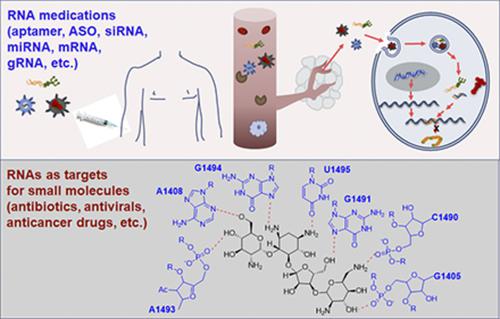当前位置:
X-MOL 学术
›
Pharmacol. Rev.
›
论文详情
Our official English website, www.x-mol.net, welcomes your
feedback! (Note: you will need to create a separate account there.)
RNA Drugs and RNA Targets for Small Molecules: Principles, Progress, and Challenges.
Pharmacological Reviews ( IF 19.3 ) Pub Date : 2020-10-01 , DOI: 10.1124/pr.120.019554 Ai-Ming Yu 1 , Young Hee Choi 1 , Mei-Juan Tu 2
Pharmacological Reviews ( IF 19.3 ) Pub Date : 2020-10-01 , DOI: 10.1124/pr.120.019554 Ai-Ming Yu 1 , Young Hee Choi 1 , Mei-Juan Tu 2
Affiliation

|
RNA-based therapies, including RNA molecules as drugs and RNA-targeted small molecules, offer unique opportunities to expand the range of therapeutic targets. Various forms of RNAs may be used to selectively act on proteins, transcripts, and genes that cannot be targeted by conventional small molecules or proteins. Although development of RNA drugs faces unparalleled challenges, many strategies have been developed to improve RNA metabolic stability and intracellular delivery. A number of RNA drugs have been approved for medical use, including aptamers (e.g., pegaptanib) that mechanistically act on protein target and small interfering RNAs (e.g., patisiran and givosiran) and antisense oligonucleotides (e.g., inotersen and golodirsen) that directly interfere with RNA targets. Furthermore, guide RNAs are essential components of novel gene editing modalities, and mRNA therapeutics are under development for protein replacement therapy or vaccination, including those against unprecedented severe acute respiratory syndrome coronavirus pandemic. Moreover, functional RNAs or RNA motifs are highly structured to form binding pockets or clefts that are accessible by small molecules. Many natural, semisynthetic, or synthetic antibiotics (e.g., aminoglycosides, tetracyclines, macrolides, oxazolidinones, and phenicols) can directly bind to ribosomal RNAs to achieve the inhibition of bacterial infections. Therefore, there is growing interest in developing RNA-targeted small-molecule drugs amenable to oral administration, and some (e.g., risdiplam and branaplam) have entered clinical trials. Here, we review the pharmacology of novel RNA drugs and RNA-targeted small-molecule medications, with a focus on recent progresses and strategies. Challenges in the development of novel druggable RNA entities and identification of viable RNA targets and selective small-molecule binders are discussed.
中文翻译:

RNA 药物和小分子 RNA 靶点:原则、进展和挑战。
基于 RNA 的疗法,包括作为药物的 RNA 分子和 RNA 靶向小分子,为扩大治疗靶点范围提供了独特的机会。各种形式的RNA可用于选择性地作用于常规小分子或蛋白质无法靶向的蛋白质、转录本和基因。尽管RNA药物的开发面临着前所未有的挑战,但已经开发出许多策略来改善RNA代谢稳定性和细胞内递送。许多RNA药物已被批准用于医疗用途,包括机械作用于蛋白质靶点的适体(例如pegaptanib)和小干扰RNA(例如patisiran和givosiran)以及直接干扰蛋白质靶标的反义寡核苷酸(例如inotersen和golodirsen) RNA 靶标。此外,引导RNA是新型基因编辑模式的重要组成部分,并且正在开发用于蛋白质替代疗法或疫苗接种的mRNA疗法,包括针对前所未有的严重急性呼吸综合征冠状病毒大流行的疗法。此外,功能性 RNA 或 RNA 基序具有高度结构化,可形成小分子可接近的结合袋或裂口。许多天然、半合成或合成抗生素(如氨基糖苷类、四环素类、大环内酯类、恶唑烷酮类和苯酚类)可以直接与核糖体RNA结合,从而实现对细菌感染的抑制。因此,人们对开发适合口服给药的RNA靶向小分子药物越来越感兴趣,并且一些药物(例如risdiplam和branaplam)已进入临床试验。在此,我们回顾新型RNA药物和RNA靶向小分子药物的药理学,重点关注最新进展和策略。 讨论了开发新型可成药 RNA 实体以及鉴定可行的 RNA 靶标和选择性小分子结合物方面的挑战。
更新日期:2020-09-15
中文翻译:

RNA 药物和小分子 RNA 靶点:原则、进展和挑战。
基于 RNA 的疗法,包括作为药物的 RNA 分子和 RNA 靶向小分子,为扩大治疗靶点范围提供了独特的机会。各种形式的RNA可用于选择性地作用于常规小分子或蛋白质无法靶向的蛋白质、转录本和基因。尽管RNA药物的开发面临着前所未有的挑战,但已经开发出许多策略来改善RNA代谢稳定性和细胞内递送。许多RNA药物已被批准用于医疗用途,包括机械作用于蛋白质靶点的适体(例如pegaptanib)和小干扰RNA(例如patisiran和givosiran)以及直接干扰蛋白质靶标的反义寡核苷酸(例如inotersen和golodirsen) RNA 靶标。此外,引导RNA是新型基因编辑模式的重要组成部分,并且正在开发用于蛋白质替代疗法或疫苗接种的mRNA疗法,包括针对前所未有的严重急性呼吸综合征冠状病毒大流行的疗法。此外,功能性 RNA 或 RNA 基序具有高度结构化,可形成小分子可接近的结合袋或裂口。许多天然、半合成或合成抗生素(如氨基糖苷类、四环素类、大环内酯类、恶唑烷酮类和苯酚类)可以直接与核糖体RNA结合,从而实现对细菌感染的抑制。因此,人们对开发适合口服给药的RNA靶向小分子药物越来越感兴趣,并且一些药物(例如risdiplam和branaplam)已进入临床试验。在此,我们回顾新型RNA药物和RNA靶向小分子药物的药理学,重点关注最新进展和策略。 讨论了开发新型可成药 RNA 实体以及鉴定可行的 RNA 靶标和选择性小分子结合物方面的挑战。































 京公网安备 11010802027423号
京公网安备 11010802027423号